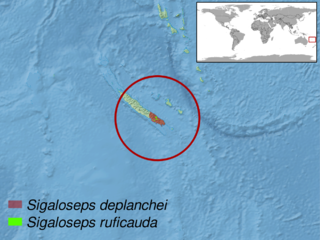
Skinks are lizards belonging to the family Scincidae, a family in the infraorder Scincomorpha. With more than 1,500 described species across 100 different taxonomic genera, the family Scincidae is one of the most diverse families of lizards. Skinks are characterized by their smaller legs in comparison to typical lizards and are found in different habitats except arctic and subarctic regions.

Sigaloseps is a genus of skinks which inhabit the moist, closed forest of southern New Caledonia.
In August 2018, the IUCN Red List of Threatened Species identified 6086 Vulnerable species, subspecies and varieties, stocks and sub-populations in the Animalia kingdom.

Eugongylinae is a subfamily of skinks within the family Scincidae. The genera in this subfamily were previously found to belong the Eugongylus group in the large subfamily Lygosominae.
Sigaloseps balios is a species of skink found in New Caledonia.
Sigaloseps conditus is a species of skink that are found in New Caledonia.

Sigaloseps deplanchei, Deplanche's shiny skink, is a species of lizard in the family Scincidae. The species is endemic to New Caledonia.
Sigaloseps pisinnus is a species of skink found in New Caledonia.

Sigaloseps ruficauda is a species of skink found in New Caledonia.




